Continuing with my edge triggered ramp generator and its simulation, thanks to all your help I have the LTspice simulation set up that I can see a theoretical circuit work that uses the rising edge of the inverted ripple-carry output (RCO) at the end of a counter to trigger the ramp generator.
This is all jolly nice, but of course the currents of over 2A involved here are completely nuts. So, I put in what I computed the right values for Rhigh and Rlow of that 74LS04 TTL inverter that I'm using:
- Rhigh = 5V / 0.4mA = 12.5kΩ
- Rlow = 5V / 16mA = 312.5Ω
and when I use these values, of course I can not ever properly discharge that capacitor C1.
So, I need some other trick to rip the current valves wide open based on a little triggering butterfly flapping its wings. I think I know what I will try. That's this feed-back coupled NPN-PNP pair instead of my simple NPN:
I know it's ridiculous, a screen shot from a video, of a guy filming an old book. But hey, this seems like the most applicable solution for me and I take'em where I find'em.
my annotation arrows are my own guessing. In fact I don't understand how that "end of period reset" transistor pair would work. since it seems like the entire discharge current of the (selectable) capacitor needs to flow through the base of the NPN transistor.
So I focus on the triggering side there. But there it's the same thing, in the end the current needs to be queezed from the collector of the PNP through the base of the NPN in order to go to ground. But at least here the base current of the PNP takes the collector-emitter path of the NPN and helps out.
I'm probably still not quite clear about all of this. So I took another video where it's simpler and the guy explains it better. So I came up with this here:
and as you can see, I tweaked the TTL inverter parameters again because I have positive proof that the edge detection circuit works from my earlier exercise, and the proof is in the scope pictures here: How do I make a 74LS170 or 74LS670 register file reliably clock in data on the rising edge?. So, TTL signal edge detected, I can only get this over the TTL threashold if I reduce the Rhigh value from 12.5kΩ to 0.5kΩ.
I am incredulous about this, as it again shows high current peaks through C2, but in practice I showed it works. And so I take that same 0.5kΩ for the positive edge detection to be inverted again, so that the down-spike should now open the Q2-Q3 pair to drain C1 quickly.
But I am still confused now how I should correctly estimate the TTL impedances to high and low, because I am doubting that I can sink enough current during low on A2 to open that Q2-Q3 pair.
What say you?
PS: I will now simplify my positive edge detection RC to a negative edge detection RC, which I have built for an EEPROM programmer. Perhaps I don't need these TTL gates after all...
PS: here is my ramp.asc if anyone wants to play with the same:
Version 4
SHEET 1 1420 680
WIRE -64 -144 -240 -144
WIRE 96 -144 -64 -144
WIRE 96 -32 96 -64
WIRE -240 0 -240 -144
WIRE -64 16 -64 -64
WIRE 32 16 -64 16
WIRE 96 96 96 64
WIRE 208 96 96 96
WIRE -64 128 -64 16
WIRE 96 144 96 96
WIRE 352 144 272 144
WIRE 448 144 352 144
WIRE 640 144 512 144
WIRE 688 144 640 144
WIRE 752 144 688 144
WIRE 880 144 816 144
WIRE 1008 144 944 144
WIRE 288 192 208 192
WIRE 640 192 640 144
WIRE 688 192 688 144
WIRE 1008 192 1008 144
WIRE -240 272 -240 80
WIRE -64 272 -64 208
WIRE -64 272 -240 272
WIRE 96 272 96 208
WIRE 96 272 -64 272
WIRE 352 272 352 240
WIRE 352 272 96 272
WIRE 640 272 640 256
WIRE 640 272 352 272
WIRE 688 272 640 272
WIRE 1008 272 688 272
WIRE -64 304 -64 272
WIRE 800 464 768 464
FLAG -64 304 0
SYMBOL res -80 -160 R0
SYMATTR InstName R1
SYMATTR Value 2.2k
SYMBOL res -80 112 R0
SYMATTR InstName R2
SYMATTR Value 10k
SYMBOL res 80 -160 R0
SYMATTR InstName R3
SYMATTR Value 12k
SYMBOL cap 80 144 R0
SYMATTR InstName C1
SYMATTR Value 470p
SYMBOL pnp 32 64 M180
WINDOW 0 60 74 Left 2
WINDOW 3 28 42 Left 2
SYMATTR InstName Q1
SYMATTR Value BC556B
SYMBOL npn 288 144 R0
WINDOW 0 52 21 Left 2
WINDOW 3 31 53 Left 2
SYMATTR InstName Q2
SYMATTR Value BC546B
SYMBOL voltage -240 -16 R0
WINDOW 123 0 0 Left 0
WINDOW 39 24 124 Left 2
SYMATTR InstName V1
SYMATTR Value 5
SYMBOL voltage 1008 176 R0
WINDOW 3 44 86 Left 2
WINDOW 123 0 0 Left 0
WINDOW 39 0 0 Left 0
SYMATTR InstName V2
SYMATTR Value PULSE(0 5 0 0 0 500n 64u 100)
SYMBOL Digital\\inv 944 80 M0
WINDOW 3 -261 7 Left 2
WINDOW 123 -245 -19 Left 2
SYMATTR InstName A1
SYMATTR Value Vhigh=5V Rhigh=312.5
SYMATTR Value2 Vlow=0V Rhigh=0.5k
SYMBOL cap 816 128 R90
WINDOW 0 0 32 VBottom 2
WINDOW 3 32 32 VTop 2
SYMATTR InstName C2
SYMATTR Value 22p
SYMBOL res 672 176 R0
SYMATTR InstName R5
SYMATTR Value 1k
SYMBOL diode 656 256 R180
WINDOW 0 24 64 Left 2
WINDOW 3 24 0 Left 2
SYMATTR InstName D1
SYMBOL pnp 272 192 R180
WINDOW 0 55 77 Left 2
WINDOW 3 24 44 Left 2
SYMATTR InstName Q3
SYMATTR Value BC556B
SYMBOL Digital\\inv 512 80 M0
WINDOW 3 -261 7 Left 2
WINDOW 123 -245 -19 Left 2
SYMATTR InstName A2
SYMATTR Value Vhigh=5V Rhigh=312.5
SYMATTR Value2 Vlow=0V Rhigh=0.5k
TEXT -274 328 Left 2 !.tran 96u
UPDATE: well, I just built one with a N-MOSFET
the trick here is the MOSFET with very low threshold required and pretty low resistance. But it is built from a real part that I might get.
UPDATE: or I stay at home and use what I have, just do the good old Darlington pair. Thanks to my explorations in power amplification.






